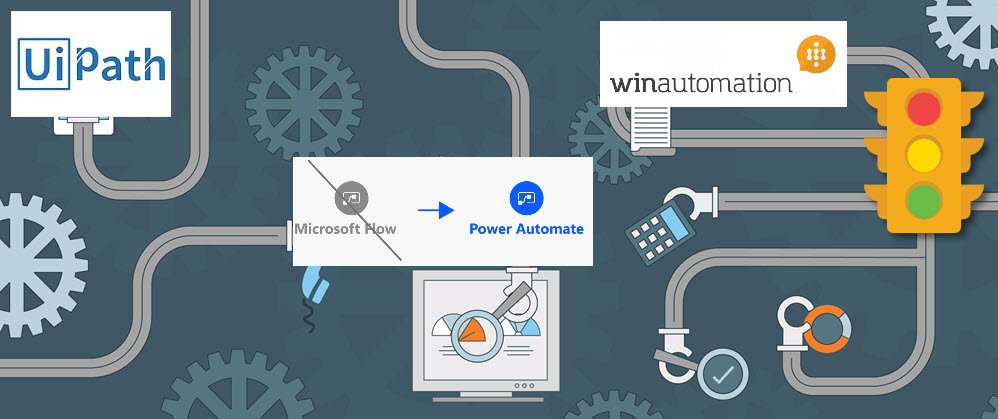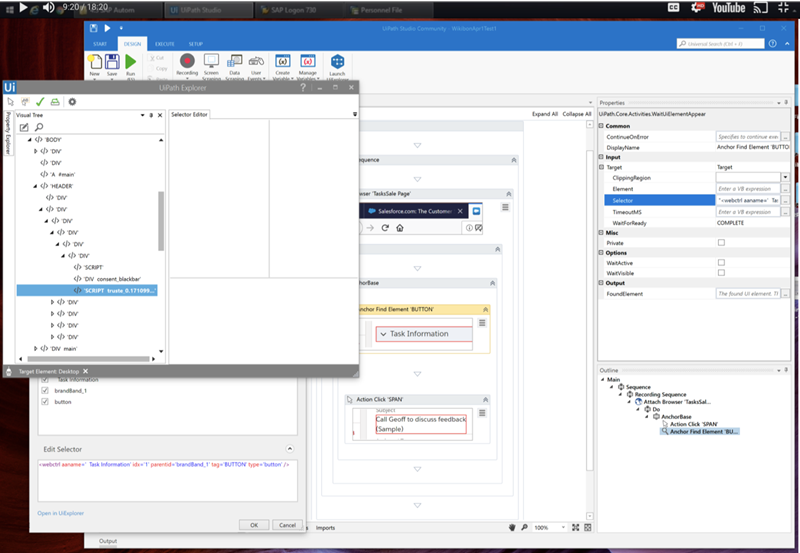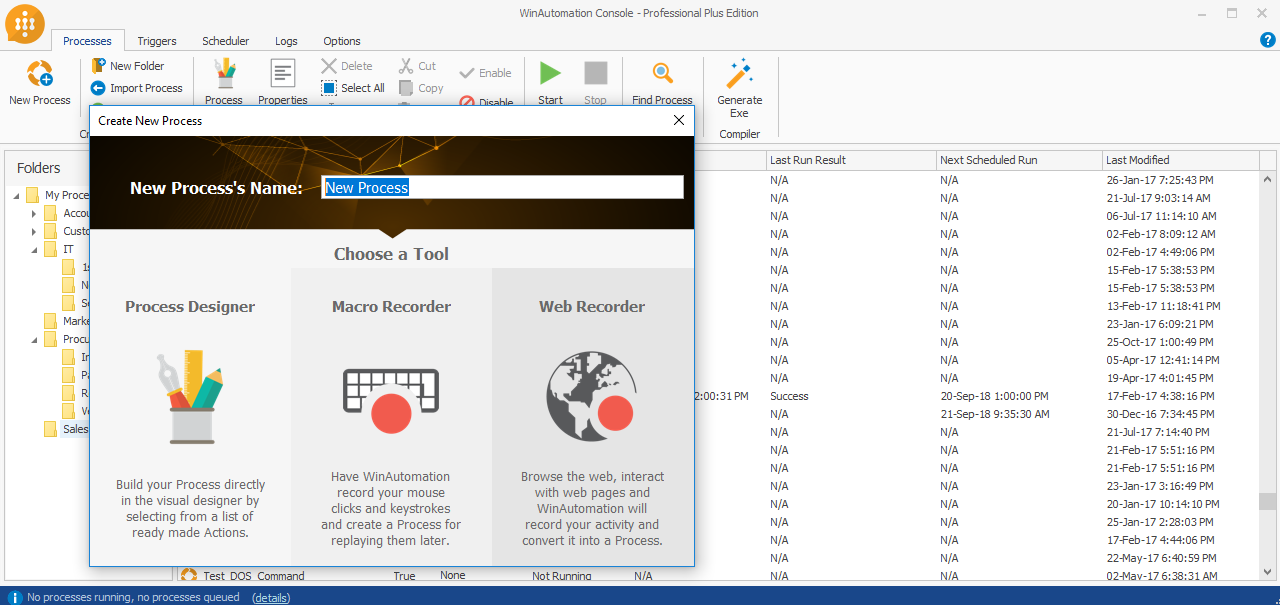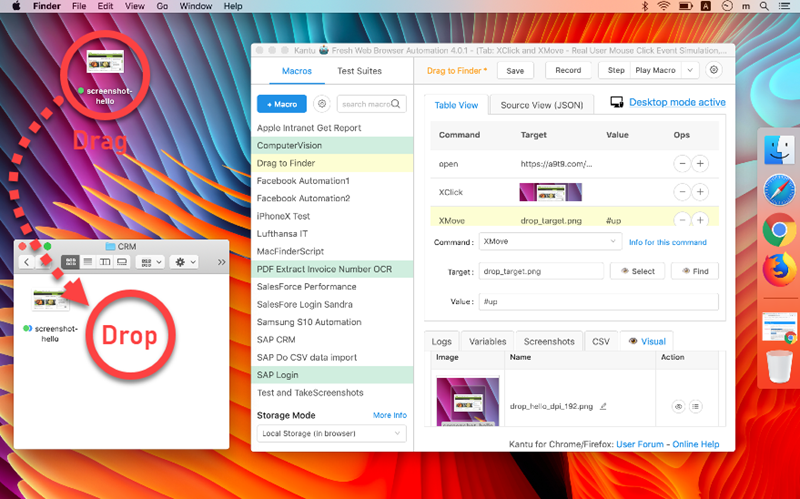
RPA 2020: UIPath vs Power Automate
Recently Microsoft acquired Softomotive, a robotic process automation (RPA) company to help beef up its somewhat lacking Power Automate product. Is it now a competitor to UIPath?
In this post we compare UIPath with Power Automate and the UI.Vision RPA software.
UIPath vs Power Automate
The table below compares the key features of the two well-known Robotic Process Automation (RPA) tools. As third option it includes the specs of UI.Vision RPA, the popular lightweight and open-source alternative to the big name RPA tools.
| Feature | UIPath | Power Automate | UI.Vision |
|---|---|---|---|
| Enterprise Pricing | Very expensive | Expensive | free-$5000 |
| Subscription Required | yes | yes | no |
| Free Version available | Some features | Trial only | Yes |
| Number of users | 6000 (paid) | 9000 (paid) | 60,000 (free) |
| Supported Platforms | Win only | Win only | Win, Mac, Linux |
| Open-Source | no | no | yes |
| Security Rating | Good | Good | Very Good |
| Openness | Medium (Open forums) | Low (Forum not very active) | Very high (Open-Source, Forums) |
| Desktop Automation | |||
| Image Recognition | Yes | Yes (WinAutomation) | Yes |
| Text Recognition (OCR) | Yes | Yes (WinAutomation) | Yes |
| Citrix Automation | Yes | Yes | Yes |
| Web Automation | |||
| Supported Browser | IE, Chrome, Firefox | IE, Chrome, Firefox | Chrome, Firefox, Edge |
| Browser Recorder | Yes | Yes | Yes |
| Selenium IDE compatible | No | No | Yes |
| Scripting | |||
| Script language | VB | VBScript | Many (API) |
| Advanced Scheduling | Yes | Yes | With external tools |
In addition to comparing UIPath and Automation Anywhere, the table above contains the UI.Vision RPA software specs, a popular lightweight alternative to the big name RPA tools. The number of users in the table above is based on the latest press releases from UIPath, Power Automate and the active user count of UI.Vision RPA in Chrome store.
At a9t9 we work in the computer vision, AI and usability space, so this is where we focus our comparison.
Enterprise Pricing
Lets start with the price. The clear winner here is Power Automate. With prices starting at $500 per flow and $40 per user the license is much more affordable then the hidden and expensive UIPath pricing. Still, just like UIPath Power Automate is a subscription (SaaS): Once you stop paying, your macros stop working. That is unlike for example our own UI.Vision RPA software, which is sold as a one-time purchase and never expires.
Security
Both UIPath and Microsoft are well-known trustworthy companies. But their code is closed source. So you must trust these companies that they do not send of critical corporate information to outside servers. By contrast, the UI.Vision RPA core is open-source, so you can easily check that no information is send anywhere. We require a software to be Open-Source to be eligible for a very good security rating.
Desktop Automation
Compared with UIPath, Power Automate was clearly lacking in the desktop automation area. This has changed with its acquisition of Softomotive in May 2020. Founded in 2005, the Greece and London-based Softomotive is a RPA provider with more than 9,000 customers, and is the creator of desktop tool WinAutomation.
Power Automate has no computer vision and OCR features on its own. But they added them with the acquisition of Softomotive now:
In Power Automate (formerly called Microsoft Flow), Microsoft will use Softomotive’s tools to enable a number of new capabilities, including Softomotives low-code desktop automation solution WinAutomation. Until now, Power Automate did not feature any desktop automation tools. Softomotives other flagship application, ProcessRobot for server-based enterprise RPA development (e. g. SAP automation), will also find a new home in Power Automate. My guess, though, is that Microsoft mostly bought the company for its desktop automation skills. We have always believed in the notion of citizen developers and, since less than two percent of the world population can write code, we believe the greatest potential for both process improvement and overall innovation comes from business end users. The goal is that non-technical business end users can not just do more, but also make deeper contributions by becoming professional problem solvers and innovators. So any innovation in the RPA software space is welcome.
PRO Tip: For desktop automation to work, you need to keep the desktop unlocked. This is true for all RPA software tools. The best way to do this securely is to run the automation in an unlocked virtual machine (VM) inside a locked server. For the virtual machine, we recommend to use a Linux machine, since Linux VMs are much smaller and faster then a comparable Windows VM. And there are no license issues with Linux. Using a Linux VM for desktop automation is only possible with the UI.Vision RPA tool. UIPath and Power Automate/Winautomation can not utilize Linux VMs, as they are Windows only tools.
Web Automation
Here UIPath and Winautomation work about the same.
Web automation means Browser Automation. It is the ability to automate tasks directly in the web browser. Typical tasks include form filling, data up- and download and web scraping, the extraction from information from websites. For web automation UI.Vision RPA brings a key advantage to the table by having Selenium-compatible commands. So if you know Selenium, you will be right at home with UI.Vision RPA. And in the other direction, if you know how to automate tasks with UI.Vision RPA, you are trained for the Selenium IDE at the same time.
Scripting
All automation tools have one thing in common: Unless the task or test to automate is very basic, you must expect to have to “script” or “program” part of the solution. UIPath uses an proprietary visual languge. In addition it supports the VB.NET language, a language that is rarely used otherwise. Blue Prism uses the more popular C#. Winautomation uses VBScript. And UI.Vision exposes a command line API that allows you to use it with any programming or scripting language, for example (in alphabetic order) C#, Java, Node.JS, PowerShell, Python, VB.NET, VBS and to combine it with other tools like AutoHotKey.
UIPath and Power Automate / Winautomation IDE
The UIPath tools allow the user to “draw” a workflow within a flow chart editor. This is helpful for beginners and marketed as “no coding” solution. Here is how this looks:

UIPath has a modern-looking UI but “Programming by flowchart” was pioneered by LabView decades ago. Visual programming remained a niche solution since “flow chart source code” becomes very difficult to debug and maintain as your scripts grows. And sharing code snippets is difficult, as you can not copy and paste “flowcharts” easily e. g. in a forum. These are two of the many reasons why it remained a niche.

The Winautomation UI has no flow chart options. It is a rather complex user interface, but with many powerful options and connector options. It is developer friendly.

By contrast, the UI.Vision RPA tool uses the classic text based approach, similar to other known tools like the Selenium IDE. UI.Vision focuses on computer-vision and AI powered automation. For everything else, UI.Vision can be combined with any scripting or programming language like Powershell or Python. For example, for Office automation you are better of using the standard Microsoft VBA scripting, instead of the proprietary Word and Excel components of UIPath.
Last but not least: Do not confuse Microsoft Power Automate with the Microsoft PowerShell scripting language. These are completely different products and have nothing in common, except that they are both from Microsoft.
Summary
Microsoft Power Automate is a powerful automation tool best used by those with technical experience (such as developers). Like UIPath it is Windows only, offering no support for Mac or Linux automation. Training is geared towards technically proficient users and does not cater to end business users. Depending on the users, this tool can work well. However, the use case should be flushed out before choosing Microsoft Power Automate. Additionally, the pricing is very competitive, making this a strong option in the business automation world.
UiPath is built to allow end business users to code and automate their own processes. But this still requires training, it is no golden bullet either. Some suggest that their platform for automation is more intuitive for users who are not technically oriented including business analysts, accountants, and financial professionals, but we find them to be about the same.
RPA Market Overview
For more RPA Market Overview blog posts please see
- UIPath vs Power Automate (this post)
- UIPath vs Automation Anywhere
- UIPath Pricing
- UIPath vs Blue Prism
- AutoHotKey vs AutoIT
- Sikuli vs AutoHotKey
- Selenium IDE vs Katalon vs UI.Vision
Planned future reviews: Cognizant, Contextor (acquired by SAP), FortressIQ, Kofax, Kryon Systems, NICE Systems, Pegasystems and WorkFusion.